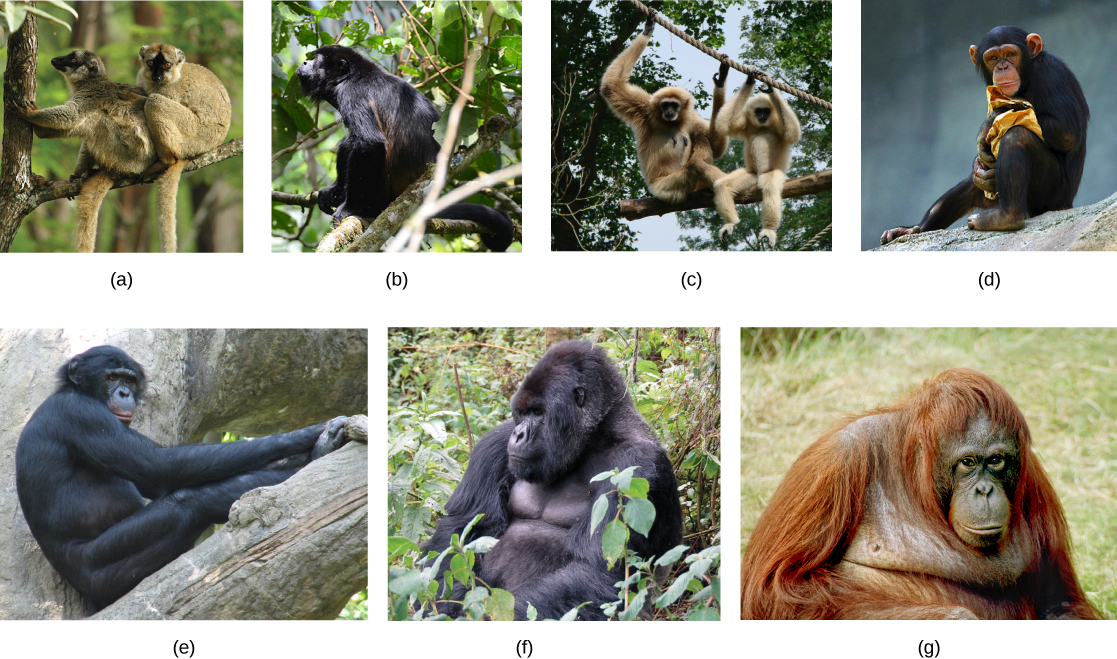| << Chapter < Page | Chapter >> Page > |
Order Primates of class Mammalia includes lemurs, tarsiers, monkeys, and the apes, which include humans. Non-human primates live primarily in tropical or subtropical regions of South America, Africa, and Asia. They range in size from the mouse lemur at 30 grams (1 ounce) to the mountain gorilla at 200 kilograms (441 pounds). The characteristics and evolution of primates are of particular interest to us as they allow us to understand the evolution of our own species.
All primate species have adaptations for climbing trees, as they all descended from tree-dwellers, although not all species are arboreal. This arboreal heritage of primates resulted in hands and feet that are adapted for brachiation , or climbing and swinging through trees. These adaptations include, but are not limited to 1) a rotating shoulder joint, 2) a big toe that is widely separated from the other toes and thumbs that are widely separated from fingers (except humans), which allow for gripping branches, and 3) stereoscopic vision , two overlapping visual fields, which allows for the depth perception necessary to gauge distance. Other characteristics of primates are brains that are larger than those of many other mammals, claws that have been modified into flattened nails, typically only one offspring per pregnancy, and a trend toward holding the body upright.
Order Primates is divided into two groups: prosimians and anthropoids. Prosimians include the bush babies of Africa, the lemurs of Madagascar, and the lorises, pottos, and tarsiers of Southeast Asia. Anthropoids include monkeys, lesser apes, and great apes ( [link] ). In general, prosimians tend to be nocturnal, smaller in size than anthropoids, and have relatively smaller brains compared to anthropoids.

The earliest vertebrates that diverged from the invertebrate chordates were the jawless fishes. Hagfishes are eel-like scavengers that feed on dead invertebrates and other fishes. Lampreys are characterized by a toothed, funnel-like sucking mouth, and some species are parasitic on other fishes. Gnathostomes include the jawed fishes (cartilaginous and bony fishes) as well as all other tetrapods. Cartilaginous fishes include sharks, rays, skates, and ghost sharks. Bony fishes can be further divided into ray-finned and lobe-finned fishes.
As tetrapods, most amphibians are characterized by four well-developed limbs, although some species of salamanders and all caecilians are limbless. Amphibians have a moist, permeable skin used for cutaneous respiration. Amphibia can be divided into three clades: salamanders (Urodela), frogs (Anura), and caecilians (Apoda). The life cycle of amphibians consists of two distinct stages: the larval stage and metamorphosis to an adult stage.
The amniotes are distinguished from amphibians by the presence of a terrestrially adapted egg protected by amniotic membranes. The amniotes include reptiles, birds, and mammals. A key adaptation that permitted reptiles to live on land was the development of scaly skin. Reptilia includes four living clades: Crocodilia (crocodiles and alligators), Sphenodontia (tuataras), Squamata (lizards and snakes), and Testudines (turtles).
Birds are endothermic amniotes. Feathers act as insulation and allow for flight. Birds have pneumatic bones that are hollow rather than tissue-filled. Airflow through bird lungs travels in one direction. Birds evolved from dinosaurs.
Mammals have hair and mammary glands. Mammalian skin includes various secretory glands. Mammals are endothermic, like birds. There are three groups of mammals living today: monotremes, marsupials, and eutherians. Monotremes are unique among mammals as they lay eggs, rather than giving birth to live young. Eutherian mammals have a complex placenta.
There are 16 extant (living) orders of eutherian mammals. Humans are most closely related to Primates, all of which have adaptations for climbing trees, although not all species are arboreal. Other characteristics of primates are brains that are larger than those of other mammals, claws that have been modified into flattened nails, and typically one young per pregnancy, stereoscopic vision, and a trend toward holding the body upright. Primates are divided into two groups: prosimians and anthropoids.

Notification Switch
Would you like to follow the 'Concepts of biology' conversation and receive update notifications?